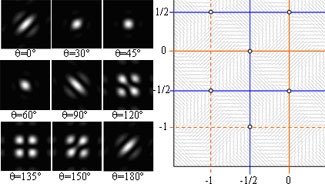Optical polarization vortex generation by means of a liquid cristal microdisplay

Optical vortices are points in which either the phase or the state of polarization of a wavefront remains undefined. The wavefront adopts then zero intensity at these points. Optical vortices are lately receiving a great interest in the scientific community due to their singular physical and mathematical properties, as well as for their use as elements to optically trap particles. In this work we have proposed a polarization mask divided in four quadrants, like that shown in Fig. 1. Light becomes linearly polarized in vertical direction in two quadrants and becomes horizontally polarized in the other two.
Figure 2 shows the wavefront generated by this diffraction screen when it is illuminated with linearly polarized light oriented at 45�. Figures 2(a), 2(b) and 2(c) show respectively the intensity and the state of polarization. Some characteristic lines are observed in which the state of polarization is either equal to the incident one (I lines) or the orthogonal state (H lines). A polarization vortex is generated whenever these two types of lines cross. Figure 2(d) shows the intensity when an analyzer is placed before the diffraction plane. The properties of the diffraction pattern change as the analyzer is rotated (the angle indicates the direction of the transmission axis). These results have been reproduced by means of the microdisplay, in which the polarization mask has been generated by addressing different voltages to different pixels.
(1)Universitat Autònoma de Barcelona
(2)Universidad Miguel Hernández de Elche
References
“Polarization vortices generation by diffraction from a four quadrant polarization mask”. Ignacio Moreno, Claudio Iemmi, Juan Campos, María J. Yzuel, A Vargas,Optics Communications 276, 222-230 (2007)

